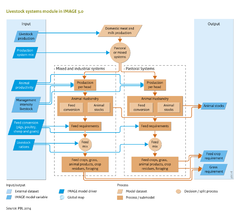Livestock systems/Policy issues: Difference between revisions
Jump to navigation
Jump to search
No edit summary |
No edit summary |
||
| Line 1: | Line 1: | ||
{{ComponentPolicyIssueTemplate | {{ComponentPolicyIssueTemplate | ||
|Description=Between 1970 and 2010, global grass consumption increased by more than 40% (see figure below), while global grassland area only increased about 5% from 3134 to 3313 million hectares in the same period (see the figure in the policy intervention example section). The global area of pastoral grassland only shows slight and gradual changes. | |Description=Between 1970 and 2010, global grass consumption increased by more than 40% (see figure below), while global grassland area only increased about 5% from 3134 to 3313 million hectares in the same period (see the figure in the policy intervention example section). The global area of pastoral grassland only shows slight and gradual changes. | ||
While extensive pastoral production systems have changed little, mixed and industrial systems have moved rapidly towards intensification. Most baseline scenarios indicate that a similar slow increase in grassland area is required over the coming decades as observed historically. Under the baseline scenario from the [[Roads from Rio+20 (2012) project |Rio+20]] study, these developments result in a small increase of 2% in global grassland area ( | While extensive pastoral production systems have changed little, mixed and industrial systems have moved rapidly towards intensification. Most baseline scenarios indicate that a similar slow increase in grassland area is required over the coming decades as observed historically. Under the baseline scenario from the [[Roads from Rio+20 (2012) project |Rio+20]] study, these developments result in a small increase of 2% in global grassland area (see the figure in the policy intervention example section), but this will require considerable productivity increases in many parts of the world as discussed in [[Bouwman et al., 2005]]. | ||
|Example=A larger proportion of livestock production in mixed systems will inherently increase overall feed conversion ratios of ruminants; | |Example=A larger proportion of livestock production in mixed systems will inherently increase overall feed conversion ratios of ruminants; | ||
*production parameters, such as milk production per animal, carcass weight and off-take rates, will have an effect on the feed conversion ratio, which in general will be lower in more productive animals; | *production parameters, such as milk production per animal, carcass weight and off-take rates, will have an effect on the feed conversion ratio, which in general will be lower in more productive animals; | ||
Revision as of 17:32, 5 May 2014
Parts of Livestock systems/Policy issues
| Component is implemented in: |
| Components: |
| Related IMAGE components |
| Projects/Applications |
|
| Models/Databases |
| Key publications |
